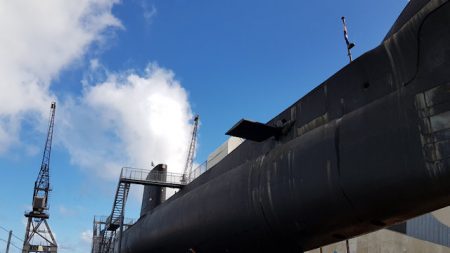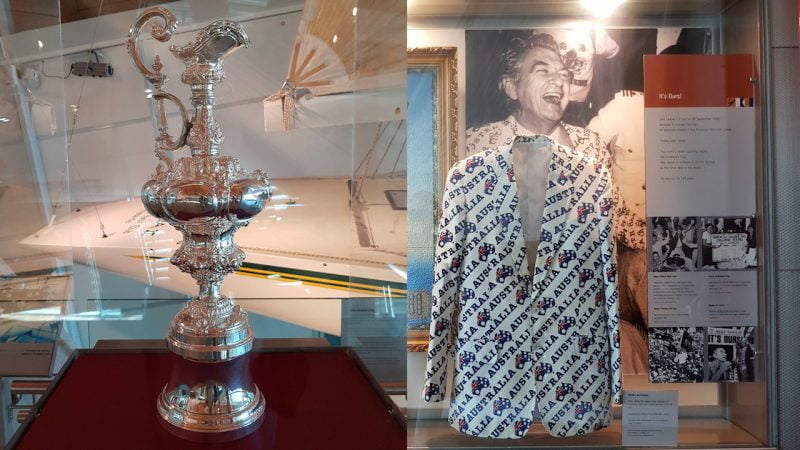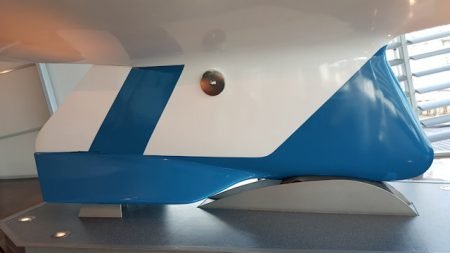
Fremantle has a long maritime history as a major port in Western Australia. Along with the Shipwrecks Museum, the Maritime Museum provides a glimpse of the importance of maritime industry to the coastal city.
The museum is made up of a number of galleries with various aspects of Western Australia’s maritime relationship.
One of the main attractions at the Maritime Museum is the HMAS Ovens, a Cold War era Oberon class submarine from the Royal Australian Navy. The HMAS Oven is the first submarine to be preserved as a museum ship in Australia.
The HMAS Ovens sits beside the museum on Fremantle’s historic World War II submarine slipway. A guided tour takes you through the submarine to get a feel for what it was like for those who served aboard.
The tour is not available to young children and you need to be OK climbing through tight enclosed spaces and climbing up scaffolding stairs and ladders. It starts by climbing up to the deck at the front of the submarine, then descending into the hull at the torpedo tubes.

The guide was amazing, giving plenty of information about the operations and other details throughout the submarine. From the torpedo room, we then progressed through towards the back, passing through the cramped Sailors Mess, the cramped kitchen, the cramped Wardroom, the cramped… I’m sure you get it.
The main operations room is full of a mesmerising array dials and switches and bits and pieces. In the centre is the shaft rising from below the floor and through the roof – the periscope that rises above the surface of the water when the submarine is below the waves. The guide showed us photos of the various apparatuses that rises above, in addition to the periscope.
Walking through the engine room you stand between the two massive V16 diesel engines that power the submarine through the oceans. There are few gauges in the engine room compared to the control room but there are still quite a few there. Each cylinder pair has a gauge, 8 gauges for each engine.
The engines don’t power the propellers directly, instead, they drive 1280kW electric generators that then either directly power 2200kW electric motors or charge two 7420Ah batteries. Built between the 1950s and 1970s, the Oberon class submarines predate the Toyota Prius Hybrid by 4 decades or more. Can you imagine how long those batteries will keep the Waeco running on a long camping trip?
The diesel engines operate only when direct air is available, either while the submarine is on the surface or through snorkels when submerged at periscope depth.
Australia had six Oberon class submarines. Four can be found around the country, including HMAS Ovens. HMAS Onslow is at the Australian National Maritime Museum in Darling Harbour, and HMAS Otama is in Westernport Bay in Victoria.
Others are partially represented. The fin, outer hull and stern of the HMAS Otway are at Holbrook in New South Wales. HMAS Oxley’s fin is on Garden Island in Western Australia, at the Navy base HMAS Stirling. Lastly, HMAS Orion’s fin is at Rockingham Naval Memorial Park on the Rockingham Coastal Drive, also in Western Australia.
The museum isn’t all about the Oberon class submarine though, there are many other interesting displays and vessels in the collection, such as the whaling industry, significant in the early days with a small whaling boat, not much bigger than a modern tinny. Barrels, pots, harpoons, and other equipment are on display.
Quarantine practices was common in the 1800s and the earlier parts of 1900s, a display in the museum acknowledges quarantining in Western Australia with many ports having quarantine stations or lazarettes to isolate those who are or suspected of being infected. Woodman Point Quarantine Station, south of Fremantle, operated between 1886 and 1979.
The length of stay depends on the disease. The Plague, for which quarantining was first used to contain it in the 1300s, spread over the world at the end of the 1800s. Western Australia had 80 cases recorded. Isolation for the plague was 40 days, a fair bit longer than the 14 days we isolate for COVID-19, and they didn’t have Netflix.
The emphasis of quarantining with shipping is more on guarding against exotic pests, including plants and animals and diseases they can have. Ballast water from ships can introduce new species and organisms so ships are required to exchange ballast water while out at sea.
The history of Fremantle and the origins of its name is shown. Captain Charles Howe Fremantle landed at the Swan River in 1829 to claim the land for Britain, over 40 years after the settlement of the First Fleet on the eastern coast of Australia in Port Jackson. The site is believed to be roughly where the Maritime Museum is located.
Fremantle was known as Manjaree or Walyalup to the Aboriginal Nyoongar people, an important meeting and trading place. The Nyoongar people thought the early explorers were djanga, spirits of relatives who had passed away returning home again. Settlers were welcomed and sometimes avoided, however, the visiting settlers became invaders which led to blood shed.


A famous vessel from the 1980s is a yacht that made boat races exciting and triggered a national celebration. Australia II won the America’s Cup, the first time in 126 years the cup left New York Yacht Club in America. Locked in a tie with three wins each out of seven races against the American yacht Liberty. Australia II fought back in the last race after being nearly a minute behind on the last mark to sneak passed to take the prize.
Australia II’s win made Ben Lexcen a familiar name in Australian households, the designer of the radical design of the keel, and triggered Prime Minister Bob Hawke’s declaration that “any boss who sacks anyone for not turning up today is a bum”. The suit jacket Bob Hawke was wearing that day, with “Australia” and the Australian flag in the shape of Australia plastered all over it is on display near Australia II.
The prices for entry to the museum are great for families with children getting free access.
To get there:

From Perth head east on Stirling Hwy, later veering to the right towards Fremantle on Queen Victoria St. Follow Queen Victoria St across the bridge over Swan River. At the lights, turn right to continue on Queen Victoria St for 500m then turn right into James St. At the end of James St, turn left onto Beach St. Follow Beach St for 1.3km becoming Phillimore St. Continue straight ahead over the railway crossing and head towards the right, then straight ahead (just before crossing over the railway again) onto Peter Hughes Dr. Follow Peter Hughes Dr for 100m and turn left towards parking. The entrance to the museum is at the far end of the parking area.
Heading west on Canning Hwy, follow towards Fremantle. Passing the shipping container rainbox (Rainbox Sea Container), continue for another 700m and turn right into James St. At the end of James St, turn left onto Beach St. Follow Beach St for 1.3km becoming Phillimore St. Continue straight ahead over the railway crossing and head towards the right, then straight ahead (just before crossing over the railway again) onto Peter Hughes Dr. Follow Peter Hughes Dr for 100m and turn left towards parking. The entrance to the museum is at the far end of the parking area.


